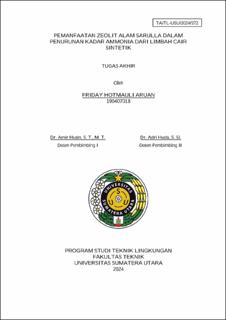Pemanfaatan Zeolit Alam Sarulla dalam Penurunan Kadar Ammonia dari Limbah Cair Sintetik
Utilization of Sarulla Natural Zeolite in Reducing Ammonia Levels from Synthetic Wastewater

Date
2024Author
Aruan, Friday Hotmauli
Advisor(s)
Husin, Amir
Huda, Adri
Metadata
Show full item recordAbstract
Ammonia is a pollutant that could damage the water ecosystem and reduce the surface water quality. Ammonia concentration in unspoiled surface water is less than 0,1 mg/L, but the increase of human activities that produce waste such as industrial waste, agricultural and animal farming waste and even domestic waste that reached surface water causing the ammonia concentration in surface water increasing. Ammonia removal from wastewater could be done with the adsorption process using Sarulla natural zeolite as an adsorbent. Sarulla natural zeolite is an adsorbent with high affinity towards ammonia, low cost and available in abundance in the environment, especially in North Sumatera. In this present study, Sarulla natural zeolite was used in a continuous adsorption process with two main parameters. The first parameter is adsorbent bed height with three variations such as 2 cm, 4 cm and 6 cm. The second parameter is ammonia initial concentration with three variations such as 100 mg/L, 125 mg/L and 150 mg/L. Both of the main parameters are then used to calculate the adsorption capacity (qo) of Sarulla natural zeolite. Experimental data was analysed using Thomas and Yoon-Nelson adsorption kinetic models. Adsorption kinetics analysis shows the experimental data fit with Thomas and Yoon-Nelson adsorption kinetic models with correlation coefficient value is above 0,9. The result shows that the increasing of bed height decreases ammonia adsorption capacity because ammonia removal is unequivalent with the amount of adsorbent used in the process. The increasing of ammonia initial concentration increases the ammonia adsorption capacity because the highest ammonia removal by adsorbent is found at higher ammonia initial concentration. The best condition of ammonia removal was found at 2 cm of bed height and 150 mg/L of initial concentration with the adsorption capacity reached 15,3551 mg/g
Collections
- Undergraduate Theses [404]
